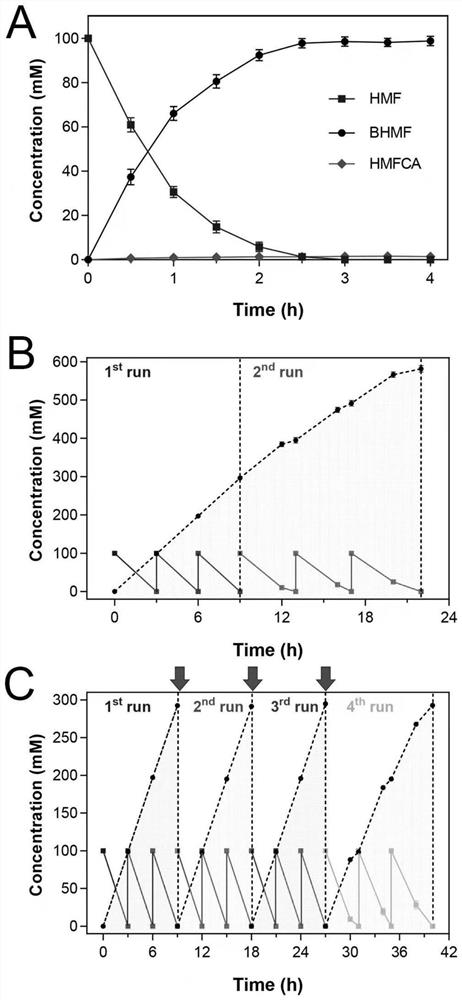Enterobacter ludwigii and application thereof
A technology of Enterobacter ludwigii and Enterobacter dewighi, which is applied in the field of biochemistry, can solve the problems of low substrate tolerance concentration, toxicity, and slow HMF conversion speed, and achieves mild conditions, simple operation, and selectivity. good sex effect
- Summary
- Abstract
- Description
- Claims
- Application Information
AI Technical Summary
Problems solved by technology
Method used
Image
Examples
Embodiment 1
[0028] Enterobacter ludwigii YYP3 will be obtained from the surrounding soil samples of Nanjing and Suzhou pharmaceutical factories and other samples using the screening medium containing 5-hydroxymethylfurfural.
[0029] (1) After dissolving the soil samples with deionized water, the supernatant was spread on the screening solid medium for cultivation, the cultivation temperature was 35 °C, and the cultivation time was 48 h.
[0030] (2) The single colonies obtained in step (1) were respectively picked into LB liquid medium for enrichment culture, the culture temperature was 30° C., the shaking speed was 180 rpm, and the culture time was 12 h to obtain seed liquid.
[0031] (3) Centrifuge the seed solution obtained in step (2), collect cells, wash with phosphate buffer (pH 7.0, 100 mM), and finally suspend in phosphate buffer containing HMF for transformation test. The volume of phosphate buffer (100 mM) was 4 mL, containing 50 mM HMF (ie, the initial HMF concentration), the ...
Embodiment 2
[0040] This example illustrates the effect of co-substrate glucose concentration on HMF conversion and BHMF selectivity in the reaction of Enterobacter ludwigii YYP3 catalyzed production of BHMF.
[0041]A single colony of Enterobacter ludwigii YYP3 was picked and inoculated into LB liquid medium, cultured at a temperature of 30° C. and a shaker rotation speed of 180 rpm for 12 hours to obtain a seed solution. The seed solution was centrifuged, the cells were collected, washed, and finally dispersed in 5 bottles of phosphate buffered saline containing different concentrations of glucose for transformation detection. Among them, the volume of phosphate buffer (100mM) is 4mL, containing 50mM HMF and different concentrations of glucose (the molar ratios of glucose and HMF are 0:1, 0.25:1, 0.5:1, 0.75, 1:1, respectively), pH was 7.0. Since the phosphate buffer component here is before the cells are added, the HMF concentration therein is the initial HMF concentration in the trans...
Embodiment 3
[0044] This example illustrates the effect of the pH of the transformation system on the HMF conversion rate and BHMF selectivity in the reaction of Enterobacter ludwigii YYP3 catalyzing the production of BHMF.
[0045] A single colony of Enterobacter ludwigii YYP3 was picked and inoculated into LB liquid medium, cultured at a temperature of 30° C. and a shaker rotation speed of 180 rpm for 12 hours to obtain a seed solution. The seed solution was centrifuged, the cells were collected, washed, and finally dispersed in 6 flasks of phosphate buffered saline with different pH (5.5, 6.0, 6.5, 7.0, 7.5, 8.0) for transformation detection. The volume of phosphate buffer (100 mM) was 4 mL, containing glucose and 50 mM HMF, the molar ratio of glucose to HMF was 0.75:1, and the pH was 5.5, 6.0, 6.5, 7.0, 7.5 or 8.0. The transformation reaction was carried out in a shaker with a rotation speed of 200 rpm, the cell dosage was 20 mg / mL (wet weight), and the transformation temperature was 3...
PUM
| Property | Measurement | Unit |
|---|---|---|
| Volume | aaaaa | aaaaa |
Abstract
Description
Claims
Application Information
 Login to View More
Login to View More - R&D
- Intellectual Property
- Life Sciences
- Materials
- Tech Scout
- Unparalleled Data Quality
- Higher Quality Content
- 60% Fewer Hallucinations
Browse by: Latest US Patents, China's latest patents, Technical Efficacy Thesaurus, Application Domain, Technology Topic, Popular Technical Reports.
© 2025 PatSnap. All rights reserved.Legal|Privacy policy|Modern Slavery Act Transparency Statement|Sitemap|About US| Contact US: help@patsnap.com


